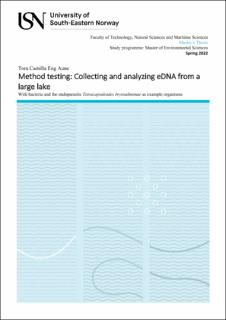Method testing: Collecting and analyzing eDNA from a large lake - With bacteria and the endoparasite Tetracapsuloides bryosalmonae as example organisms
Master thesis
Permanent lenke
https://hdl.handle.net/11250/3040776Utgivelsesdato
2022Metadata
Vis full innførselSamlinger
Sammendrag
As techniques and protocols for eDNA studies develop, ideas for research are pouring in. The need for standardized methods and protocols for different environments is increasing and it´s necessary to ensure reliable data that can be tested. This study aims to test methods to collect eDNA in a freshwater lake to detect the endoparasite Tetracapsuloides bryosalmonae and bacteria, to collect data that can contribute towards the standardization of eDNA sampling. eDNA were collected at five stations located around lake Norsjø in Southeast Norway, with four different sample strategies referred to as sample types, volume, mixed samples (1 and 2L), direct samples (1 and 2L), and sample station. Detection of the parasite was done with real time qPCR and bacteria with 16S Barcoding Kit 1-24 (SQK- 16S024) from Oxford Nanopore. The parasite was only found in five samples, due to the small amount of data, the parasite was not used for any further analysis. Bacteria, on the other hand, was detected in all samples that were used for metabarcoding (except for blanks). Further statistical analysis showed that the sample stations were the most important factor in the collection of eDNA from Lake Norsjø and explained 35,6 % of the differences in beta diversity of the sequenced samples.
